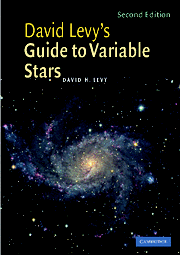Book contents
- Frontmatter
- Contents
- Foreword to the first edition
- Preface
- Acknowledgments
- Part I Getting to know the sky
- 1 Beginning with the Big Dipper
- 2 Magnitude, color, and distance
- 3 A word on binoculars and telescopes
- 4 Learning to see
- Part II Getting to know the variables
- Part III Suggested variables for observation throughout the year
- Part IV A miscellany
- Index
2 - Magnitude, color, and distance
from Part I - Getting to know the sky
Published online by Cambridge University Press: 05 August 2012
- Frontmatter
- Contents
- Foreword to the first edition
- Preface
- Acknowledgments
- Part I Getting to know the sky
- 1 Beginning with the Big Dipper
- 2 Magnitude, color, and distance
- 3 A word on binoculars and telescopes
- 4 Learning to see
- Part II Getting to know the variables
- Part III Suggested variables for observation throughout the year
- Part IV A miscellany
- Index
Summary
What is the first thing you notice about the stars? Quite likely, it is their differing brightnesses. Although this appears obvious, it is the single most important concept with which you should become familiar before you can be a variable-star observer.
Magnitude
Why do stars differ in brightness? Is it because they are at different distances from us, so that the farther stars appear fainter, like the glow from lamps at the far end of the street? Or are the stars themselves of different brightnesses? As you have likely guessed, both are correct. Sirius, a blue star off the southeast corner of Orion the Hunter, is normally the brightest star in the night sky, not so much because it is actually large and bright, but because it is close. At a mere 8 light years away, Sirius is one of our nearest neighbors. However, there exists a star only a little farther away; Wolf 359 is a “red dwarf” star whose intrinsic brightness is so low that it cannot be seen with the unaided eye. Famed in Star Trek legend as the site of a Borg battle, Wolf 359 is a red dwarf star. Meanwhile, the brightest star in Cygnus the Swan, Deneb, is well over 1000 light years away from us, and is one of the intrinsically brightest stars in the sky. S Doradus is even brighter, but it appears to us as a faint star because it is so far away, actually in a neighboring galaxy.
- Type
- Chapter
- Information
- David Levy's Guide to Variable Stars , pp. 10 - 12Publisher: Cambridge University PressPrint publication year: 2005

